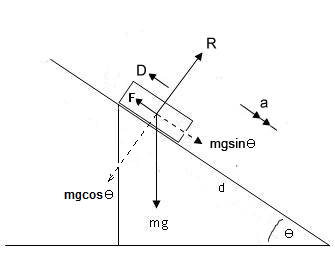A truck pulls boxes up an incline plane. The truck can exert a maximum force of #3,500 N#. If the plane's incline is #(5 pi )/12 # and the coefficient of friction is #7/12 #, what is the maximum mass that can be pulled up at one time?
1 Answer
Maximum mass is
Explanation:

For our diagram,
If we apply Newton's Second Law up perpendicular to the plane we get:
# R - mg cos theta = 0 #
# :. R = mg cos((5pi)/12) \ \ N#
With a maximum driving force of
# D + F - mg sin theta = 0 #
# :. 3500 +F - mg sin ((5pi)/12) = 0#
# :. F = mg sin ((5pi)/12) - 3500#
And the friction is related to the Reaction (Normal) Force by
# F le mu R #
# :. mg sin ((5pi)/12) - 3500 le 7/12 (mg cos((5pi)/12) )#
# :. 12mg sin ((5pi)/12) - 42000 le 7mg cos((5pi)/12) #
# :. 12mg sin ((5pi)/12) - 7mg cos((5pi)/12) le 42000 #
# :. mg(12 sin ((5pi)/12) - 7 cos((5pi)/12)) le 42000 #
# :. m le 42000/((12 sin ((5pi)/12) - 7 cos((5pi)/12))g) #
# :. m le 438.2400291 ... #

